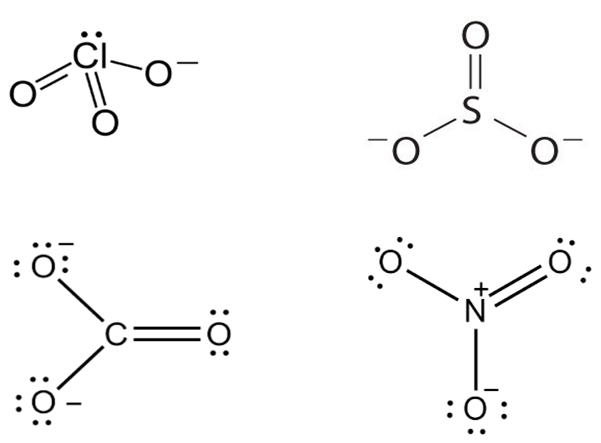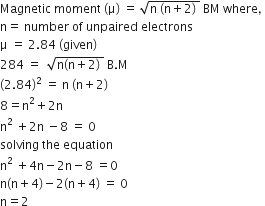Which of the following species contains an equal number of σ and Π bond?
-
HCO3-
-
XeO4
-
(CN)2
-
CH2(CN)2
B.
XeO4
|
Structure |
σ and Π |
|
|
σ bond -4 |
|
|
σ bond -4 |
|
|
σ bond -3 |
|
|
σ bond -6 |
Sponsor Area
Which of the following species contains an equal number of σ and Π bond?
HCO3-
XeO4
(CN)2
CH2(CN)2
B.
XeO4
|
Structure |
σ and Π |
|
|
σ bond -4 |
|
|
σ bond -4 |
|
|
σ bond -3 |
|
|
σ bond -6 |
Sponsor Area
The species Ar, K+ and Ca2+ contain the same number of electrons. In which order do their radii increase?
Ar < K+< Ca2+
Ca2+ < Ar < K+
Ca2+ < K+ < Ar
K+< Ar < Ca2+
B.
Ca2+ < Ar < K+
Ca2+ < K+ < Ar
Ar, K+ and Ca2+ are isoelectronic i.e with the same number of electrons, 18. For isoelectronic species, ionic radii decrease with increases in effective (relative) positive charge. Also Ar, K and Ca belong to the same period.
Solubility of the alkaline earth's metal sulphates in water decreases in the sequence
Mg>Ca>Sr>Ba
Ca>Sr>Ba>Mg>
Sr>Ca>Mg>Ba
Ba>Mg>Sr>Ca
A.
Mg>Ca>Sr>Ba
The solubility of the sulphates. The sulphates becomes less soluble as you fo down the group i.e
Mg> Ca>Sr> Ba
The magnitude of the lattice energy remains almost constant as the size of the sulphate ion is so big that small increase in the size of the cation from Be to Ba does not make any difference. However, the hydration energy decreases from Be2+ to Ba2+ appreciably as the size of the cation increases down the group. The significantly high solubility of MgSO4 is due to high enthalpy of solvation on the smaller Mg2+ ions.
Which of the following pairs of ions are isoelectronic and isostructural?
D.
Isostructural chemical compounds have similar chemical structures.
Isoelectronic terms refer to two atom, ions or molecules that have the same number of valence electrons.
ClO3- = SO32-
Number of electrons
CO32- = 6+2+24 =32
SO32- = 16+2+24 = 32
ClO32- = 17+24+1 = 42
NO32- = 7+2+24 = 33
Hence ClO32- and SO32- are isoelectronic and are pyramidal in shape.
Magnetic moment 2.84 BM is given by (At. no. Ni= 28, Ti= 22, Cr=24, Co = 27)
Ni2+
Ti3+
Cr3+
Co2+
A.
Ni2+

Sponsor Area
Mock Test Series